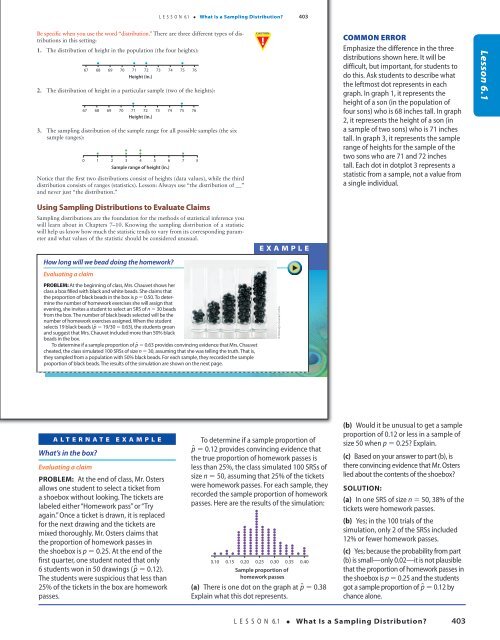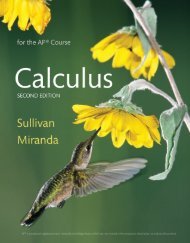SPA 3e_ Teachers Edition _ Ch 6
You also want an ePaper? Increase the reach of your titles
YUMPU automatically turns print PDFs into web optimized ePapers that Google loves.
L E S S O N 6.1 • What Is a Sampling Distribution? 403<br />
Be specific when you use the word “distribution.” There are three different types of distributions<br />
in this setting:<br />
1. The distribution of height in the population (the four heights):<br />
d d d d<br />
67 68 69 70 71 72 73 74 75 76<br />
Height (in.)<br />
2. The distribution of height in a particular sample (two of the heights):<br />
d<br />
67 68 69 70 71 72 73 74 75 76<br />
Height (in.)<br />
3. The sampling distribution of the sample range for all possible samples (the six<br />
sample ranges):<br />
d d<br />
d d d d<br />
0 1 2 3 4 5 6 7 8<br />
Sample range of height (in.)<br />
Notice that the first two distributions consist of heights (data values), while the third<br />
distribution consists of ranges (statistics). Lesson: Always use “the distribution of __”<br />
and never just “the distribution.”<br />
d<br />
cAutIOn<br />
!<br />
Common Error<br />
Emphasize the difference in the three<br />
distributions shown here. It will be<br />
difficult, but important, for students to<br />
do this. Ask students to describe what<br />
the leftmost dot represents in each<br />
graph. In graph 1, it represents the<br />
height of a son (in the population of<br />
four sons) who is 68 inches tall. In graph<br />
2, it represents the height of a son (in<br />
a sample of two sons) who is 71 inches<br />
tall. In graph 3, it represents the sample<br />
range of heights for the sample of the<br />
two sons who are 71 and 72 inches<br />
tall. Each dot in dotplot 3 represents a<br />
statistic from a sample, not a value from<br />
a single individual.<br />
Lesson 6.1<br />
Using Sampling Distributions to Evaluate Claims<br />
Sampling distributions are the foundation for the methods of statistical inference you<br />
will learn about in <strong>Ch</strong>apters 7–10. Knowing the sampling distribution of a statistic<br />
will help us know how much the statistic tends to vary from its corresponding parameter<br />
and what values of the statistic should be considered unusual.<br />
How long will we bead doing the homework?<br />
Evaluating a claim<br />
PROBLEM: At the beginning of class, Mrs. <strong>Ch</strong>auvet shows her<br />
class a box filled with black and white beads. She claims that<br />
the proportion of black beads in the box is p 5 0.50. To determine<br />
the number of homework exercises she will assign that<br />
evening, she invites a student to select an SRS of n 5 30 beads<br />
from the box. The number of black beads selected will be the<br />
number of homework exercises assigned. When the student<br />
selects 19 black beads (p^ 5 19/30 5 0.63), the students groan<br />
and suggest that Mrs. <strong>Ch</strong>auvet included more than 50% black<br />
beads in the box.<br />
To determine if a sample proportion of p^ 5 0.63 provides convincing evidence that Mrs. <strong>Ch</strong>auvet<br />
cheated, the class simulated 100 SRSs of size n 5 30, assuming that she was telling the truth. That is,<br />
they sampled from a population with 50% black beads. For each sample, they recorded the sample<br />
proportion of black beads. The results of the simulation are shown on the next page.<br />
e XAMPLe<br />
© Monalyn Gracia/Corbis<br />
18/08/16 4:58 PMStarnes_<strong>3e</strong>_CH06_398-449_Final.indd 403<br />
Alternate Example<br />
What’s in the box?<br />
Evaluating a claim<br />
PROBLEM: At the end of class, Mr. Osters<br />
allows one student to select a ticket from<br />
a shoebox without looking. The tickets are<br />
labeled either “Homework pass” or “Try<br />
again.” Once a ticket is drawn, it is replaced<br />
for the next drawing and the tickets are<br />
mixed thoroughly. Mr. Osters claims that<br />
the proportion of homework passes in<br />
the shoebox is p 5 0.25. At the end of the<br />
first quarter, one student noted that only<br />
6 students won in 50 drawings ( p^ 5 0.12).<br />
The students were suspicious that less than<br />
25% of the tickets in the box are homework<br />
passes.<br />
18/08/16 4:58 PM<br />
To determine if a sample proportion of<br />
p^ 5 0.12 provides convincing evidence that<br />
the true proportion of homework passes is<br />
less than 25%, the class simulated 100 SRSs of<br />
size n 5 50, assuming that 25% of the tickets<br />
were homework passes. For each sample, they<br />
recorded the sample proportion of homework<br />
passes. Here are the results of the simulation:<br />
d d dddddd d<br />
d d d d d d<br />
d d d d d d<br />
d<br />
d d d d d d d<br />
d d d d d d d<br />
d d d d d d d<br />
d d d d d d d d<br />
d d d d d d d d d d<br />
d d d d d d d d d d d<br />
d d d d d d d d d d d<br />
d<br />
d d d d d d d d d d d d<br />
d d d d<br />
0.10 0.15 0.20 0.25 0.30 0.35 0.40<br />
Sample proportion of<br />
homework passes<br />
(a) There is one dot on the graph at p^ 5 0.38<br />
Explain what this dot represents.<br />
(b) Would it be unusual to get a sample<br />
proportion of 0.12 or less in a sample of<br />
size 50 when p 5 0.25? Explain.<br />
(c) Based on your answer to part (b), is<br />
there convincing evidence that Mr. Osters<br />
lied about the contents of the shoebox?<br />
SOLUTION:<br />
(a) In one SRS of size n 5 50, 38% of the<br />
tickets were homework passes.<br />
(b) Yes; in the 100 trials of the<br />
simulation, only 2 of the SRSs included<br />
12% or fewer homework passes.<br />
(c) Yes; because the probability from part<br />
(b) is small—only 0.02—it is not plausible<br />
that the proportion of homework passes in<br />
the shoebox is p 5 0.25 and the students<br />
got a sample proportion of p^ 5 0.12 by<br />
chance alone.<br />
L E S S O N 6.1 • What Is a Sampling Distribution? 403<br />
Starnes_<strong>3e</strong>_ATE_CH06_398-449_v3.indd 403<br />
11/01/17 3:53 PM




